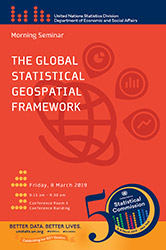United Nations Statistical Commission
Overview 50th Session (2019) Side Events
The Global Statistical Geospatial Framework
- Friday, 8 MAR 2019
- 8:15 – 9:30 am
- Conference Room 4
Meeting organized by United Nations Statistics Division and the United Nations Expert Group on the Integration of Statistical and Geospatial Information
Purpose
The objective of this side event is to provide information on the development of the Global Statistical Geospatial Framework and discuss lessons learned and advantages gained through the adoption of the Framework's five principles within national and regional contexts. In addition, the next steps in finalising the Global Statistical Geospatial Framework will be discussed, in anticipation of a global consultation for adoption of the Framework at the next session of the Statistical Commission.
Background
The 2020 Round of Housing and Population Census and the 2030 Agenda will guide how we collectively manage and transform the social, economic and environmental dimensions of humanity and our planet - at least until 2030. The data needs for censuses and to make progress on the 17 Sustainable Development Goals, targets, and global indicator framework require new data acquisition and integration approaches to improve the availability, quality, timeliness and disaggregation of data at all levels. These data needs, particularly for national implementations of the SDGs, present both a challenge and an opportunity for national statistical, geospatial, and other information systems.
The statistical and geospatial communities are at the nexus of these agendas, and are a crucial foundation to understanding, sustaining, and developing a nation's economy, society and environment. The interrelations between these three pillars are critical to sustainability and can only be uncovered and advanced through data driven, evidence based, decision making in both the public and private sectors. The increasing complexity of national and global challenges, digital transformation, and other issues have been recognised at the highest levels, and that the integration of statistical (which includes much socio-economic information) and geospatial (which includes much environmental information) will improve the relevance of the evidence on which decisions will be made - Put simply, accurately locating information on people and businesses, can result in a fuller understanding of social, economic and environmental issues, than is possible by viewing statistical or geospatial information in isolation.
As such, the Global Statistical Geospatial Framework (GSGF), and its five guiding principles, provides (i) a common approach to integrating socio-economic and environmental information, (ii) five principles to guide and inform the spatial enablement of statistical data, and (iii) acts as a bridge between the statistical and geospatial communities to integrate statistical and geospatial standards, methods, workflows, and tools. It will enable more integrated information for analysis and decision-making processes; comparisons within and between countries in a more harmonised manner; increased information on smaller geographic areas; the development of common tools/applications to support the integration and sharing of data; commercial development of geospatial tools that will further support data integration; and, ultimately, more efficient production of information.
Agenda
Introduction (15 mins)
This segment will introduce the GSGF, setting the scene, providing the journey from the endorsement of the GSGF’s five guiding principles at the 48th session of the Statistical Commission and UN-GGIM at its sixth session in 2016, through to the present day where the GSGF is primed to a global consultation following national and regional advancements in its development, adoption, and implementation.
- Chaired by:
- Scene Setting - Branko Vitas, Australia
- The GSGF, the Story to now and the Future (including the steps of the proposed consultation and endorsement of the GSGF - Paloma Merodio, Mexico
Regional Perspectives in Statistical Geospatial Integration (20 mins)
This segment considers the regional perspectives of statistical geospatial integration. This considers the regional implementation of the GSGF through the MEGA project in Latin America and the Caribbean, and how GEOSTAT3 in Europe the complements the overarching aims and objectives of the GSGF.
- Presenters:
- The GEOSTAT 3 Project: A Guide on how to Implement the GSGF for Europe - Marie Haldorson, Sweden
- Towards an Implementation of the GSGF in the Americas - Xavier Mancero, ECLAC
GSGF: Implementation national experience (25 mins/end)
While the GSGF is in the process of finalisation prior to global consultation, the five guiding principles of the GSGF have been successfully implemented nationally in numerous countries, including Australia, Egypt, Mexico, New Zealand, South Africa, Sweden, among others. This segment discusses lessons learned from implementing the five guiding principles of the GSGF and highlights how its implementation is supporting preparations for the 2020 Round of Population and Housing Censuses and the attainment of the 2030 Agenda.
- Presenters:
- Integrating Geospatial Information for the Egyptian Census - Mr Mostafa Otefy, CAMPAS, Egypt
- Implementing the GSGF in Sweden - Marie Haldorson, Sweden
- Discussion in remaining time
